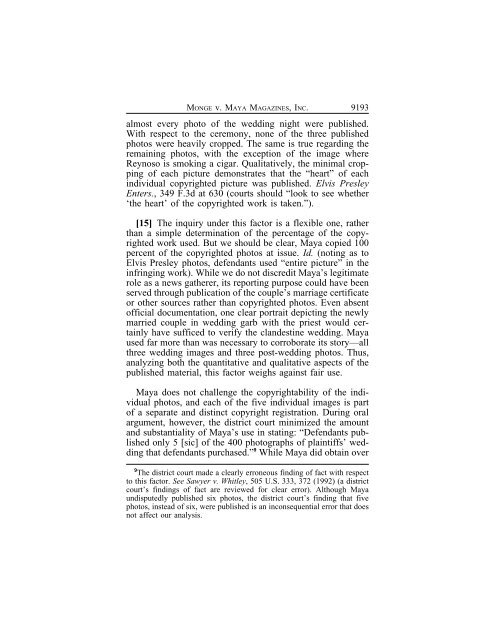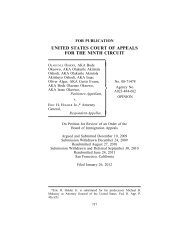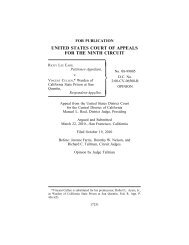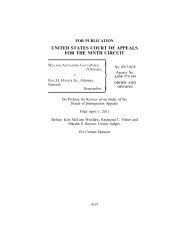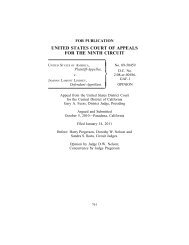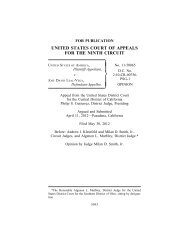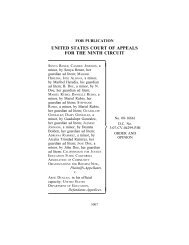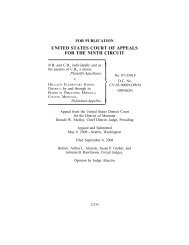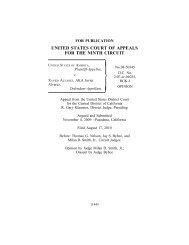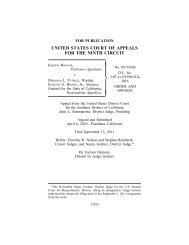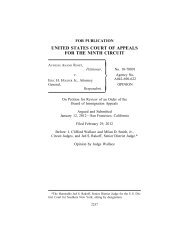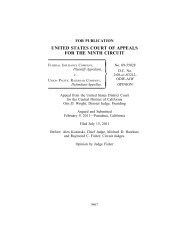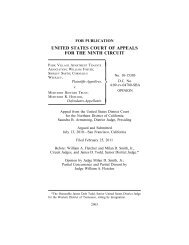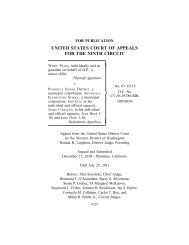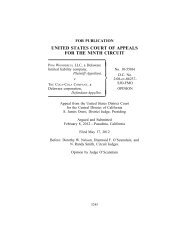NOELIA MONGE V. MAYA MAGAZINES, INC. - Ninth Circuit Court of ...
NOELIA MONGE V. MAYA MAGAZINES, INC. - Ninth Circuit Court of ...
NOELIA MONGE V. MAYA MAGAZINES, INC. - Ninth Circuit Court of ...
Create successful ePaper yourself
Turn your PDF publications into a flip-book with our unique Google optimized e-Paper software.
<strong>MONGE</strong> v. <strong>MAYA</strong> <strong>MAGAZINES</strong>, <strong>INC</strong>.<br />
9193<br />
almost every photo <strong>of</strong> the wedding night were published.<br />
With respect to the ceremony, none <strong>of</strong> the three published<br />
photos were heavily cropped. The same is true regarding the<br />
remaining photos, with the exception <strong>of</strong> the image where<br />
Reynoso is smoking a cigar. Qualitatively, the minimal cropping<br />
<strong>of</strong> each picture demonstrates that the “heart” <strong>of</strong> each<br />
individual copyrighted picture was published. Elvis Presley<br />
Enters., 349 F.3d at 630 (courts should “look to see whether<br />
‘the heart’ <strong>of</strong> the copyrighted work is taken.”).<br />
[15] The inquiry under this factor is a flexible one, rather<br />
than a simple determination <strong>of</strong> the percentage <strong>of</strong> the copyrighted<br />
work used. But we should be clear, Maya copied 100<br />
percent <strong>of</strong> the copyrighted photos at issue. Id. (noting as to<br />
Elvis Presley photos, defendants used “entire picture” in the<br />
infringing work). While we do not discredit Maya’s legitimate<br />
role as a news gatherer, its reporting purpose could have been<br />
served through publication <strong>of</strong> the couple’s marriage certificate<br />
or other sources rather than copyrighted photos. Even absent<br />
<strong>of</strong>ficial documentation, one clear portrait depicting the newly<br />
married couple in wedding garb with the priest would certainly<br />
have sufficed to verify the clandestine wedding. Maya<br />
used far more than was necessary to corroborate its story—all<br />
three wedding images and three post-wedding photos. Thus,<br />
analyzing both the quantitative and qualitative aspects <strong>of</strong> the<br />
published material, this factor weighs against fair use.<br />
Maya does not challenge the copyrightability <strong>of</strong> the individual<br />
photos, and each <strong>of</strong> the five individual images is part<br />
<strong>of</strong> a separate and distinct copyright registration. During oral<br />
argument, however, the district court minimized the amount<br />
and substantiality <strong>of</strong> Maya’s use in stating: “Defendants published<br />
only 5 [sic] <strong>of</strong> the 400 photographs <strong>of</strong> plaintiffs’ wedding<br />
that defendants purchased.” 9 While Maya did obtain over<br />
9 The district court made a clearly erroneous finding <strong>of</strong> fact with respect<br />
to this factor. See Sawyer v. Whitley, 505 U.S. 333, 372 (1992) (a district<br />
court’s findings <strong>of</strong> fact are reviewed for clear error). Although Maya<br />
undisputedly published six photos, the district court’s finding that five<br />
photos, instead <strong>of</strong> six, were published is an inconsequential error that does<br />
not affect our analysis.


